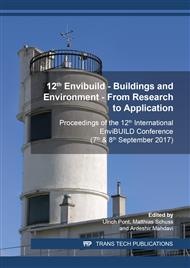p.64
p.72
p.80
p.90
p.98
p.109
p.117
p.129
p.140
Assessment of the Dynamic Temperature Profile in Fire Loaded Sandwich Structures Based on Wood in Comparison with Conventional Structural Systems
Abstract:
Fire safety is an important feature of healthy internal environment. If a fire breaks out, the interior of fire compartments within the building is exposed to very high temperatures and further phenomena accompanying the burning process. All of them impact the boundaries of the compartment structures, including the structures that are located inside them. Some structures serve the load bearing function hand in hand with fire barriers, some are only fire barriers. As to the dramatic increase of temperature, its impact upon the opposite surface of the fire separating structure should be considered, in particular regarding the behavior of the load bearing elements and their stability. This is topical at the present day, since the conventional construction materials are seen to give way to wooden sandwich structures that are preferred especially for their thermal insulation properties, low weight, small thickness and speediness of construction. The article uses dynamic simulation to illustrate how these modern structures react to high temperatures within specific time intervals, offering comparisons with traditional brick structures.
Info:
Periodical:
Pages:
98-105
Citation:
Online since:
January 2019
Authors:
Price:
Сopyright:
© 2019 Trans Tech Publications Ltd. All Rights Reserved
Share:
Citation:


